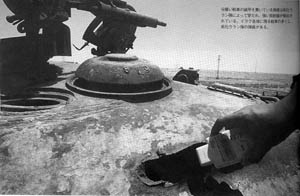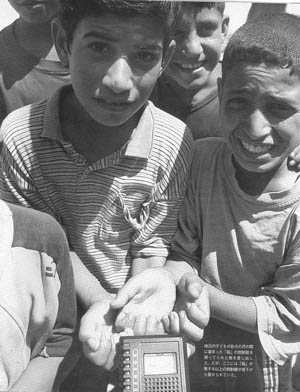Iraq – A Nuclear Polluted Land
by Toyoda Naomi
Toyoda Naomi, the acclaimed photo-journalist,here documents the human face of the U.S.-British atomic attack on the Iraqi people that raised radiation levels to 4,000 times normal levels in some areas with devastating long term effects. The article, which appeared in Shukan Kinyobi, No. 468 (July 18, 2003) was accompanied by phototgraphs presenting important visual evidence of the findings. Information on exhibitions of his work and a collection of photographs from Iraq can be found at http://www.ne.jp/asahi/n/toyoda/. Passages in italics are by the editors of Shukan Kinyobi.
American and British forces used depleted uranium in their invasion of Iraq, weapons which scattered large amounts of radioactive material over the land. It will be well nigh an eternity before the nuclear substances now polluting Iraq’s land and water disappear, and in the meantime Iraqis will have to go on suffering the effects of nuclear contamination. What the people of Iraq need is not Self-Defense Force troops to support the coalition forces, but medical assistance for the many nuclear victims of the war.
Depleted uranium (DU) is not the only radioactive contamination decaying Iraq. A large tank looted from the Nuclear Energy Research Center in Tuwaitha, a suburb of Baghdad, was abandoned in a vacant lot of a residential area. There the yellow cake (uranium concentrate) of the nuclear fuel is exposed to the air, while geese drink the muddy water in the area and sheep graze.
 |
| The bullet holes that pierced the armor of these tanks were caused by depleted uranium shells and strong radiation is observed. |
Radiation from an unidentified substance buried in front of the gate to the Al Majidah girls school nearby set off a Geiger counter alarm, but the schoolgirls play in this radiation during their break, oblivious of the danger. All of this was brought about by the U.S. and British forces invasion of Iraq.
Radiation levels 4000 times normal levels
“They say that there really were medical supplies in Iraq….” We were in a dark and stiflingly hot examination room — the lights and fan useless due to power failure — when I risked this indelicacy with Dr. Salma A. Haddad. From my interviews at hospitals in Iraq in the years of the economic sanctions, I had reported over and over again the desperation of doctors to get medicines for their leukemia and cancer patients and their sense of powerlessness in being unable to save the young lives in their care.
But now the media was awash with reports repudiating every aspect of what the Saddam Hussein regime had said and done. To tell the truth, I was beginning to wonder if I hadn’t been taken in by the regime’s propaganda.
But Dr. Salma, who is in charge of the cancer and leukemia ward at Mansur Hospital for Children, the largest children’s hospital in Iraq, and who teaches at Baghdad University, was nonplussed: “What they say is true.”
“In the past we were only able to say what the Ministry of Health and information officers told us to say, but now we have no problem in speaking frankly. Yes, there was sufficient medicine for high-ranking officials and government people. But we in the hospitals did not have medicine.”
“From 1996 to 1998 the government refused assistance from NGOs. (Three organizations managed to get a modest level of assistance in.) Some of the medicines donated by NGOs were not able to be used because there weren’t any results of clinical tests on them and they all just sat on the shelves until the expiry date ran out. Then last year we were ordered by the government to keep 25% of our medicine in stock in preparation for the war, but as these were emergency medical supplies, it had nothing to do with medicines for cancer and leukemia.”
I could not help but wonder what the lack of medicine had meant for the children of Iraq.
Land polluted by depleted uranium will never be the same again
Depleted uranium is a by-product of the uranium enrichment process. Almost 100% uranium-238, it is unusable as fuel for nuclear power generation and is treated as waste material. A hard, dense metal, it is extremely cheap, and U.S. and U.K. forces are using it for anti-tank projectiles and in attacks on buildings.
When the high-speed uranium metal projectile hits the armor of a tank, the impact creates extreme heat, melting the armor, setting the inside of the tank on fire and incinerating those inside. Uranium dust consisting of minute particles a few microns in size is diffused into the air. When breathed in it settles in the lungs, causing serious radiation damage. This radioactive oxide material is carried on the wind, which means that ordinary people kilometers away from the war zone could breathe it in.
| An old man was feeding green grass to goats by the side of a huge crater that had gathered water, having probably been created by a bunker buster. |
Depleted uranium shells that miss their mark can penetrate deep into the earth, where they react with the moisture in the soil and change into a water-soluble form of uranium that contaminates underground water.
Although it is a U.S. Department of Defense military secret, it is likely that depleted uranium is used in the bunker busters that can penetrate 20 to 30 meters into the earth and destroy enemy bunkers. Used in this way too, depleted uranium would contaminate underground water.
This uranium, passing through the ecological system, has a big impact, through water and food, on fetuses in the womb and on infants. The radioactive half-life of depleted uranium is 4.5 billion years, the age of the earth, so that one could say that for all practical purposes the contaminated land will never be the same again.
Depleted uranium weapons were used for the first time on a large scale in the Gulf War a decade ago, and since then there has been a prevalence of juvenile cancer, birth defects, stillbirths and miscarriages in Iraq. And in the U.S., Gulf War syndrome has become an issue: many U.S. soldiers suffered health problems after they returned from the front, and there have been high rates among children born to them of birth defects or cancer. (Compiled by the editors from testimony by Fujita Yuko, Associate Professor of Keio University, on July 1 before a committee hearing in the House of Councilors on the bill to allow dispatch of Japanese troops to Iraq and other sources.)
 |
| Local children extended their fingers toward me and asked that I measure the radiation in their nails and skin. But there was more radiation underground. |
The coalition forces have admitted that this time 500 tons of depleted uranium munitions were used as conventional weapons, posing, they say, no threat of radiation contamination. I ascertained for myself the use of depleted uranium munitions in the heart of the capital, Baghdad, in the course of this war. (See my article in the May 9 issue of Shukan Kinyobi)
Then in early May, along with Moritaki Haruko, who had come from Hiroshima for the Hiroshima Project for Banning Depleted Uranium Weapons, I took samples of earth and water, as well as urine samples. We measured radiation levels of from 100 to 4,000 times the normal for Iraq in Abu Ghraib west of Baghdad, in Muhammadiyat in the south, and in the outskirts of the southern city of Basra.
On July 8, the U.S. think tank, Nuclear Policy Research Institute, concluded that research on the impact of alpha radiation, the bystander effect, genomic instability and mutagenic capabilities of uranyl ions confirms that depleted uranium “is detrimental to the health of civilians and soldiers alike, particularly children” and asked the U.S. government to promptly stop its use.
 |
| As if to surround a children’s graveyard in central Basra city, I saw grave markers of citizens who became sacrificial victims of this war. |
The effects of the radioactive materials polluting the land of Iraq will appear in forms now hard to imagine in the bodies of residents in the areas in the years to come. Yet when it comes to the ability to treat what could be horrendous effects, as Dr. Salma said, the medicines just aren’t there.
Where, in the legislation for sending Japanese troops to Iraq that the Japanese Government and ruling parties are now so intent on ramming through the Diet, is there anything that speaks to this, the reality of Iraq today?
Translation by Jean Inglis for Japan Focus




